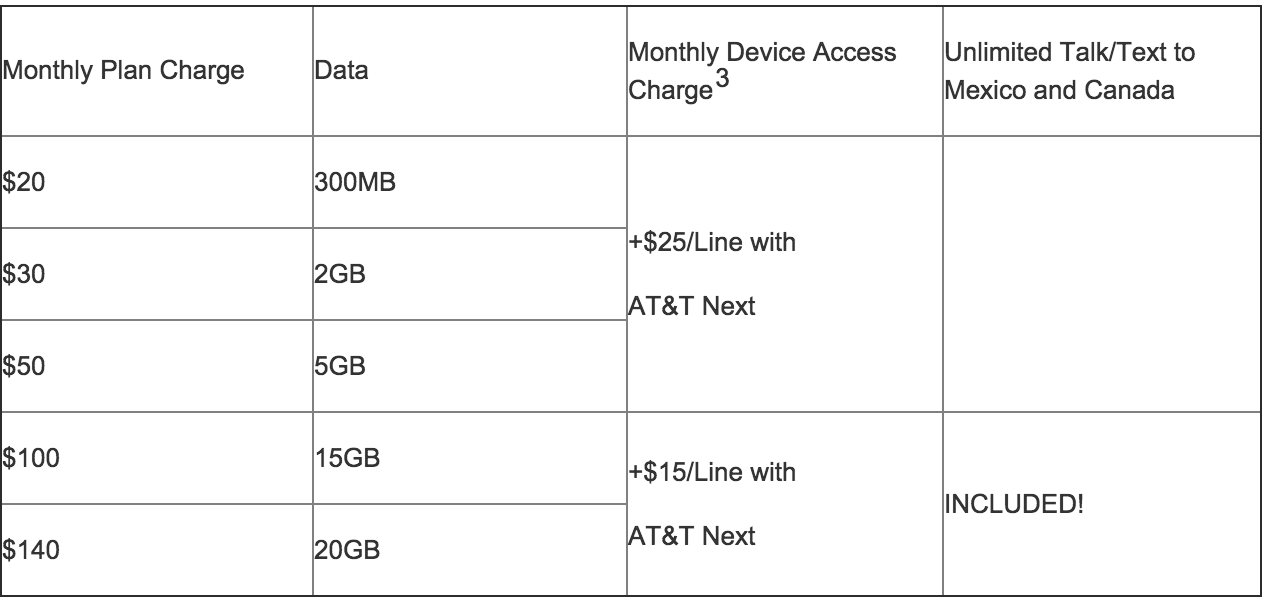AT&T Revises Data Plans: Lower Prices But Fewer Options

From AT&T’s announcement of its new data plans. Note, the monthly device charge shown is for smartphones. There are different monthly charges for other items like tablets and hotspots.
AT&T’s newest slate of data plan offerings do away with a number of existing options. No more 1GB, 3GB, 6GB, or 10GB monthly plans. Instead, AT&T has resurrected the 2GB and 5GB plans, and started giving away 15GB for the same price as it had been charging for 10GB.
Note that these changes don’t affect AT&T customers’ current plans. So if you have a 3GB plan, you’re not being automatically switched to 2GB or 5GB. But if you’re an AT&T Next user — meaning you pay for your phone through the company’s installment plan — or you are already own your phone outright, then you can switch if you want.
But whether you switch depends on your current plan and how much data you’re actually using.
For example, AT&T’s current 1GB/month offering is $25/month. The 2GB/month plan will be $30/month. Yes, it’s five dollars more per month, but the per-gigabyte price is cheaper ($15/GB vs. $25/GB). So if you’re a 1GB customer who has to be ultra-conscious of your data each month because you keep nearing your limit, it might be worth considering. But if you’re a bare-bones data user who just occasionally checks e-mail or resolves a bar bet with Wikipedia, then maybe you’re better off just saving the $5.
Customers who currently have 3GB plans ($40/month) have two directions they can go: down to 2GB or up to 5GB.
Downshifting to 2GB will actually drive up the per-gigabyte rate ($15/GB vs. $13.33/GB), but could save conservative data users $10/month if they haven’t been getting anywhere near their 3GB limit.
Jumping up to 5GB at $50/month brings that per-gigabyte cost down ($10/GB vs. $13.33/GB), but at the expense of adding $10/month to your bill. Again, if you’ve been getting near your limit or have reined in your data use to make sure you avoid overage charges, this might be worth considering.
Current 6GB ($70) customers really only have one option if they want to change and stay close to their current data limit, and that’s to downsize to 5GB. Shaving off the one gigabyte will save them a little in per-gigabyte terms ($10/GB vs. $11.66), but they should really only consider this if they are not coming near their current monthly data limit.
A 6GB customer thinking of upsizing has to jump all the way up to 15GB, which is now available at the same price ($100) that AT&T had been charging for 10GB. The math here is slightly more complicated.
Yes, there’s a significant $40/month jump in data costs. But at the same time, you’re also cutting the per-gigabyte rate in half ($6.66/GB vs. $11.66/GB). Additionally, the monthly per-device charge (if you’re on AT&T Next) drops by $10 from $25/month to $15/month. We don’t see any obvious situation in which a single person would really benefit from making this jump to the 15GB plan, but for couples or families looking for a manageable shared data plans, it might be worth comparing to your current service.
Want more consumer news? Visit our parent organization, Consumer Reports, for the latest on scams, recalls, and other consumer issues.

